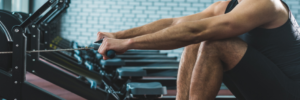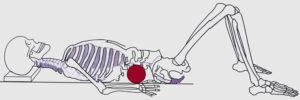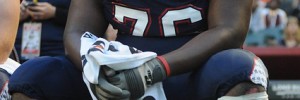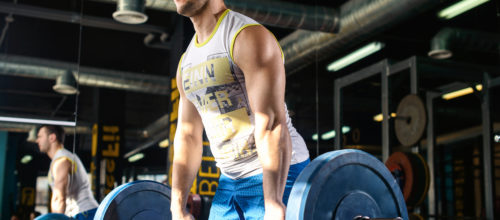
Is There an Absolute Bad Exercise? Why Context Matters
Many people will often develop beliefs that a “specific” exercise is bad and that they should “never” perform it. Sometimes these beliefs end up becoming extreme and to the point where they are falsely rooted.
For example, you will often hear people say:
“Don’t do deadlifts; they are bad for your low back.”
or…
“Don’t deep squat; it’s bad for your knees.”
These examples are usually rooted in beliefs from people who have specifically hurt themselves from these exercises or have heard stories from others who have hurt themselves. However, what they don’t tell you is what they’re technique was like when performing these lifts, their athletic history, movement quality, and any other exercises they were performing.
For instance, I threw my low back out on a poorly executed deadlift back in 2013. Now, I could have simply blamed the deadlift itself for creating my low back problems, but it’s not that simple, and there were many other factors to consider.
1. Technique – Back in 2013 and prior, I thought I knew what good deadlift technique was. However, from what I’ve learned to this day about deadlifting, I can say that back in 2013, I knew just about nothing regarding what good versus bad deadlift technique was. At the same time, I had a bit of an ego and never thought I could develop a serious injury. Well, after a few years of training poorly, I developed a severe lower back injury (L5-S1 disc herniation) that left me in horrific pain for quite some time.
2. Athletic History – I was a former hockey player and was still actively playing at a recreational level at the time. Many hockey players will end up with low back troubles (lumbar disc herniation specifically) at some point in their career since the sport of hockey involves constantly being in a flexed spinal posture, and this exact posture will beat up on a hockey player’s low back over time.
3. Movement Quality – From playing hockey for many years, I can tell you that I had some serious hip mobility restrictions that “likely” prevented me from getting into a good deadlift position several years ago when I injured my low back. As a result of this, you can probably say I wasn’t qualified to be deadlifting at that time, and this is in part why I developed an L5-S1 disc herniation.
4. Ill-advised training – While playing a pre-dominantly spinal flexion based sport, I was doing myself no favours by doing exercises like weighted crunches, sit-ups and seated leg presses at the gym. The mechanism for creating a lumbar disc herniation is repeated cycles of spinal flexion under load (Callaghan & McGill, 2001).
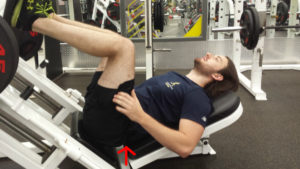
The above photo represents the classic “seated leg press” exercise performed with poor technique. Notice how the low back is rounded and not flat against the pads. This exact position could create some low back problems down the road if frequently repeated and loaded. Also, I’d consider the “seated leg press” a poor exercise choice for people with discogenic low back problems. High intradiscal pressures and changes in pelvic positioning from sitting (e.g., loss of lordosis) during the seated leg press may provoke symptoms in people with low back problems. On the flip side, the “seated leg press” exercise may be a good exercise option for someone trying to recover from a knee injury.
As you can see from the above experiences, there were much more factors at play for causing my lower back injury, and it wasn’t just solely rooted in the “deadlift” exercise. For me to blame the “deadlift” exercise itself and be like many other people who hurt there low back from deadlifting and say:
“Don’t do deadlifts; they are bad for your low back.”
That would be outright incorrect. The correct sayings should be:
“Don’t do deadlifts with poor technique; they are bad for your low back.”
“Poor exercise prescription can lead to a low back injury.”
“A long career of hockey is probably going to leave a hockey player with a beat up low back.”
Do you see where I’m going with this?
I hope so.
The deadlift itself is not to blame for my low back injury.
Rather it’s a combination of factors, and the poorly executed deadlift was just the nail on the coffin.

Good coaching is critical in preventing injuries and optimizing performance. Image licensed from “milanmarkovic78/stock.adobe.com”.
The point I’m trying to get across is that people who are often inexperienced with training will route to extreme beliefs about an exercise and blame the exercise they hurt themselves on. Instead, their actual technique on the exercise may be “bad,” or they may ignore other contributing factors that may have lead up to their injury (e.g., movement quality, ill-advised exercises or training strategies).
This inexperience is what drives these extreme beliefs about a particular “exercise” being bad, when realistically if one practices good technique, follows a quality strength & conditioning program, doesn’t have any previous or current injury restrictions, as well as moves well to perform a particular lift, then one should be well equipped to lift safely. As a result, you wouldn’t get these beliefs developing in the first place!
Now, while it’s important to recognize that this inexperience may drive some false beliefs about particular exercises being absolutely bad – does this mean that there are no bad exercises?
Well….. I’m here to tell you that.
It depends.
I wouldn’t say that there is an “absolute” bad exercise, and I would say that the context that one is using a specific exercise “in” matters most. An exercise is just a tool to achieve the desired result and in some cases that exercise can either be good or bad, depending on the individual.
From the above example illustrated, we can see that the “deadlift” is not a “bad” exercise, and rather it’s often the technique associated with the lift, the training strategies to accommodate the exercise or the previous athletic history that may be bad or may not qualify the individual for the lift. Rather than contradict the exercise completely, it’s often better to look at contradicting the individual for the exercise itself.
In my case, looking back to 2013 when I injured my low back on the deadlift, I was not “qualified” to be deadlifting, and this made the deadlift a “bad” exercise for me at the time. However, to date, I’d consider myself “now” qualified to perform the deadlift after overcoming my lower back injury, studying proper deadlifting technique and working on movement limitations that prevented me from getting into optimal position.
https://www.instagram.com/p/BV0gdllAXqr/?taken-by=remisovran
Also, to touch on on my previous coaching experiences working with professional hockey and basketball athletes, as well individuals with low back pain, I can say that there may be bad exercises for these individual’s, but it doesn’t mean they’re bad for everyone.
For instance, with the high prevalence of lumbar disc herniation’s in hockey players, I’d consider sit-ups a bad exercise choice for these athletes, as they may only further contribute to the high prevalence of lumbar disc herniation’s. However, someone that has a healthy low back and is trying to achieve a “killer” six-pack, then sit-ups may be an appropriate exercise.
On the flip side, using professional basketball players as an example, I’d consider lower body plyometrics a bad option for these athletes, considering the knee is one of the most common area’s injured (Drakos, Domb, Starkey, Callahan, & Allen, 2010). Professional basketball players have been reported to produce ground reaction forces that are close to about 9x their bodyweight when landing during a lay-up (McClay et al., 1994).
Reproducing ground reactions forces from lower body plyometrics that may be similar to the findings from McClay et al., (1994) probably isn’t the best idea if you’re looking to maintain the long-term health of professional basketball athletes. However, a youth basketball player that is trying to improve their jumping height and hasn’t sustained the same amount of miles that a professional basketball player has, lower body plyometrics may be an option for them.
Finally, using an individual with low back pain from a herniated disc now, seated exercises may be contradicted since they may provoke symptoms by changing the structure of the herniated disc (make it larger) due to the added intradiscal pressure and change in pelvic position. However, someone with a knee or ankle injury that has trouble with standing or walking may be best with seated exercises since they remove most of the stabilizing effects required by the lower body.
From the examples above, I think you get the point I’m trying to make. Many people will contradict an exercise when realistically an “exercise” is just a tool to try and help an individual achieve the desired result. In some cases, the exercise may help achieve the desired result, whereas in other cases it may achieve an unintended result (e.g., injury).
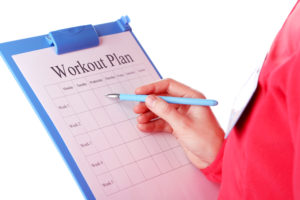
An exercise is just a tool to help achieve the intended goals of an individual. Planning the appropriate exercises and creating a well-organized workout plan is crucial in achieving optimal results.
Context Matters
As a coach looking at the “context” of the way, we prescribe exercise is more important than a just saying a “specific” exercise should be neglected all-together.
Like I mentioned at the beginning of this blog post, the belief that an exercise such as the “deadlift” is bad for your low back” is often based on a bad personal experience from an individual who did not know how to deadlift properly, wasn’t qualified to be doing the lift (e.g., hip mobility limitations), or did not know how to program the exercise appropriately.
Once an individual can rid themselves of this poor “mindset” and develop an open-minded attitude to exercise prescription, it can go a long way in helping them achieve the desired results they intend for their clients or athletes.
To summarize:
1. An exercise is just a tool to achieve the desired result, and an exercise shouldn’t be frowned upon completely.
2. The “deadlift” is bad for your low back mentality is based off cynical beliefs and should be taken with a grain of salt.
3. Context matters. It’s true that some exercises aren’t good for certain people or populations, but it’s up to good coaching to determine this through specific assessments to find out what is best and what isn’t.
Salute,
Remi
References
Callaghan, J. P., & McGill, S. M. (2001). Intervertebral disc herniation: Studies on a porcine model exposed to highly repetitive flexion/extension motion with compressive force. Clinical Biomechanics, 16(1), 28-37.
Drakos, M. C., Domb, B., Starkey, C., Callahan, L., & Allen, A. A. (2010). Injury in the National Basketball Association: A 17-Year Overview, 10021, 284–290.
McClay, I. S., Robinson, J. R., Andriacchi, T. P., Frederick, E. C., Gross, T., Martin, P., Valiant, G., Williams, K. R., Cavanagh, P. R. (1994). A Profile of Ground Reaction Forces in Professional Basketball. Journal of Applied Biomechanics, 10(3), 222–236.
Thumbnail Image Licensed from “ANR Production/stock.adobe.com”


